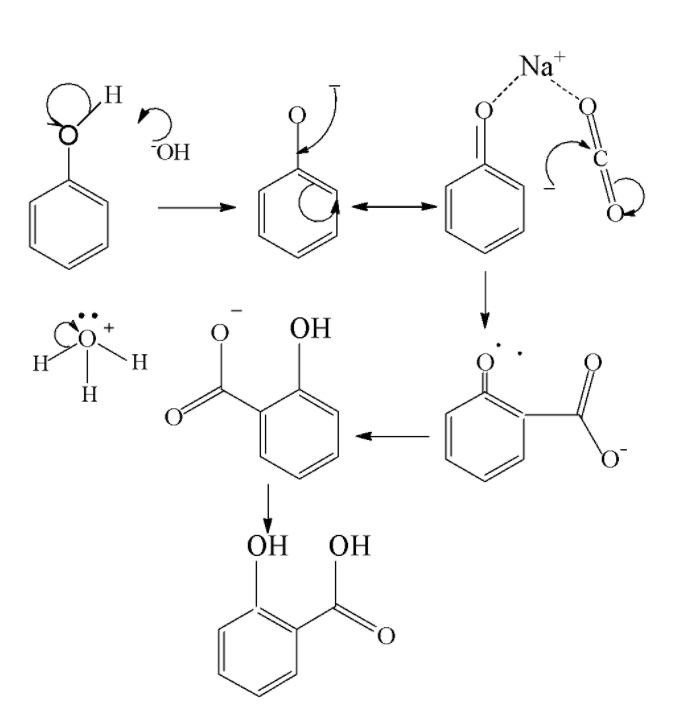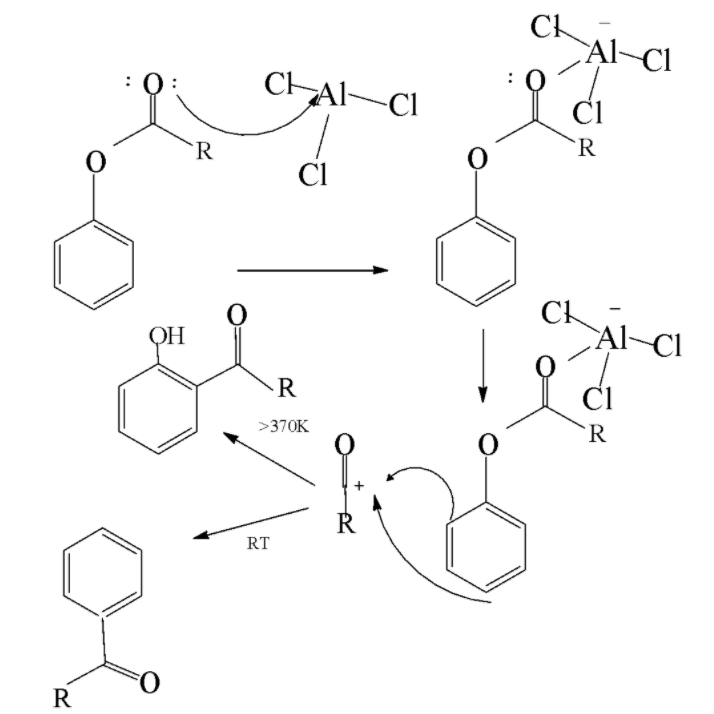
Explain Kolbe Schmitt reaction and Fries rearrangement reaction
Answer
477.6k+ views
Hint: Kolbe Schmitt reaction is also known as Kolbe’s reaction which is named after Herman Kolbe and Rudolf Schmitt which is basically a carboxylation reaction that takes place by heating sodium salt of phenol in presence of carbon dioxide at a pressure of hundred atm. Fries rearrangement reaction: It is a reaction in which a rearrangement reaction of a phenolic ester to a hydroxyl aryl ketone in the presence of Lewis acid such as aluminium chloride.
Complete step by step solution:
We consider Kolbe’s reaction first. The Kolbe reaction is aimed towards formation of an aromatic hydroxy acid known as salicylic acid by the carboxylation of sodium salt of phenol. It is an addition reaction which proceeds via the nucleophilic addition of a phenoxide to give salicylate .Then it reacts with sulfuric acid to form salicylic acid. The mechanism is shown below as follows

The electrophile here is carbon dioxide. After addition of phenoxide it reacts with sulfuric acid it forms salicylic acid as the end product.
Fries rearrangement reaction: It is a rearrangement reaction in which an aryl ester is transformed into a hydroxyl aryl ketone with the help of a Lewis acid catalyst and an aqueous acid. In this very reaction the acyl group belonging to the phenolic ester migrates to the aryl ring. The mechanism is given as follows

In the above mechanism the oxygen attached with the acyl group forms a complex with Lewis acid catalyst .Now the bond between phenolic oxygen and complex becomes polar leading to the rearrangement of the aluminium chloride bond to the phenolic oxygen. This results in the generation of acylium carbocation .Now the acylium carbocation attacks the aromatic ring and forms product via the electrophilic aromatic substitution route to form hydroxyl aryl ketone product.
Note: The Kolbe reaction is used for preparation of salicylic acid derivatives as well. Fries rearrangement is an ortho-para selective which is dependent on conditions like temperature and the solvent used in the reaction. The use of non - polar solvent favors formation of ortho products and polar solvents favor para products.
Complete step by step solution:
We consider Kolbe’s reaction first. The Kolbe reaction is aimed towards formation of an aromatic hydroxy acid known as salicylic acid by the carboxylation of sodium salt of phenol. It is an addition reaction which proceeds via the nucleophilic addition of a phenoxide to give salicylate .Then it reacts with sulfuric acid to form salicylic acid. The mechanism is shown below as follows

The electrophile here is carbon dioxide. After addition of phenoxide it reacts with sulfuric acid it forms salicylic acid as the end product.
Fries rearrangement reaction: It is a rearrangement reaction in which an aryl ester is transformed into a hydroxyl aryl ketone with the help of a Lewis acid catalyst and an aqueous acid. In this very reaction the acyl group belonging to the phenolic ester migrates to the aryl ring. The mechanism is given as follows

In the above mechanism the oxygen attached with the acyl group forms a complex with Lewis acid catalyst .Now the bond between phenolic oxygen and complex becomes polar leading to the rearrangement of the aluminium chloride bond to the phenolic oxygen. This results in the generation of acylium carbocation .Now the acylium carbocation attacks the aromatic ring and forms product via the electrophilic aromatic substitution route to form hydroxyl aryl ketone product.
Note: The Kolbe reaction is used for preparation of salicylic acid derivatives as well. Fries rearrangement is an ortho-para selective which is dependent on conditions like temperature and the solvent used in the reaction. The use of non - polar solvent favors formation of ortho products and polar solvents favor para products.
Latest Vedantu courses for you
Grade 10 | CBSE | SCHOOL | English
Vedantu 10 CBSE Pro Course - (2025-26)
School Full course for CBSE students
₹37,300 per year
Recently Updated Pages
Master Class 9 General Knowledge: Engaging Questions & Answers for Success

Master Class 9 English: Engaging Questions & Answers for Success

Master Class 9 Science: Engaging Questions & Answers for Success

Master Class 9 Social Science: Engaging Questions & Answers for Success

Master Class 9 Maths: Engaging Questions & Answers for Success

Class 9 Question and Answer - Your Ultimate Solutions Guide

Trending doubts
State and prove Bernoullis theorem class 11 physics CBSE

What are Quantum numbers Explain the quantum number class 11 chemistry CBSE

Write the differences between monocot plants and dicot class 11 biology CBSE

Who built the Grand Trunk Road AChandragupta Maurya class 11 social science CBSE

1 ton equals to A 100 kg B 1000 kg C 10 kg D 10000 class 11 physics CBSE

State the laws of reflection of light




